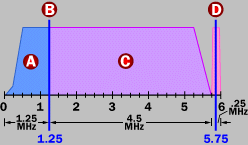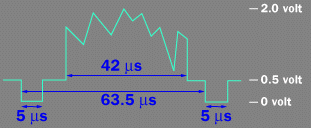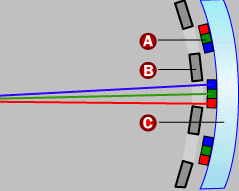|
HOME - ABOUT US - OUR PRINCIPAL - CONTACT US - TECH. RATES - EQUIP. RATES - FEE SCHEDULE - LINKS |
|||||||||||||||||
|
|
|||||||||||||||||
|
VIDEO BASICS: |
|||||||||||||||||
|
Why you need a UNIQUE ENGINEERED SOLUTION. Are you interested in a Live or Recorded Webcast? CLICK HERE. What you need to know about HOME THEATER. UES CLASSES and Certifications. Glossary of AUDIO TERMS. Glossary of STAGE TERMS. Do you have a web camera at home? Here's some LIGHTING TIPS. Read about a few PRODUCTS we are developing. (This page still unpublished.) LINKS to a few Manufacturer of Multimedia Equipment websites. A few trade publications ONLINE.
|
Standard TVs use an interlacing technique when painting the screen. In this technique, the screen is painted 60 times per second but only half of the lines are painted per frame. The beam paints every other line as it moves down the screen -- for example, every odd-numbered line. Then, the next time it moves down the screen it paints the even-numbered lines, alternating back and forth between even-numbered and odd-numbered lines on each pass. The entire screen, in two passes, is painted 30 times every second. The alternative to interlacing is called progressive scanning, which paints every line on the screen 60 times per second. Most computer monitors use progressive scanning because it significantly reduces flicker. Because the electron beam is painting all 525 lines 30 times per second, it paints a total of 15,750 lines per second. (Some people can actually hear this frequency as a very high-pitched sound emitted when the television is on.) When a television station wants to broadcast a signal to your TV, or when your VCR wants to display the movie on a video tape on your TV, the signal needs to mesh with the electronics controlling the beam so that the TV can accurately paint the picture that the TV station or VCR sends. The TV station or VCR therefore sends a well-known signal to the TV that contains three different parts:
So how does this information get transmitted to the TV? VIDEO SIGNAL A signal that contains all three of these components -- intensity information, horizontal-retrace signals, and vertical-retrace signals -- is called a composite video signal. A composite-video input on a VCR is normally a yellow RCA jack. One line of a typical composite video signal looks something like this:
The horizontal-retrace signals are 5-microsecond (abbreviated as "us" in the figure) pulses at zero volts. Electronics inside the TV can detect these pulses and use them to trigger the beam's horizontal retrace. The actual signal for the line is a varying wave between 0.5 volts and 2.0 volts, with 0.5 volts representing black and 2 volts representing white. This signal drives the intensity circuit for the electron beam. In a black-and-white TV, this signal can consume about 3.5 megahertz (MHz) of bandwidth, while in a color set the limit is about 3.0 MHz. A vertical-retrace pulse is similar to a horizontal-retrace pulse but is 400 to 500 microseconds long. The vertical-retrace pulse is serrated with horizontal-retrace pulses in order to keep the horizontal-retrace circuit in the TV synchronized. ADDING COLOR A color TV screen differs from a black-and-white screen in three ways:
The following figure shows how the shadow mask works:
When a color TV needs to create a red dot, it fires the red beam at the red phosphor. Similarly for green and blue dots. To create a white dot, red, green and blue beams are fired simultaneously -- the three colors mix together to create white. To create a black dot, all three beams are turned off as they scan past the dot. All other colors on a TV screen are combinations of red, green and blue. In the next section, you'll learn about the color TV signal. COLOR TV SIGNAL A color TV signal starts off looking just like a black-and-white signal. An extra chrominance signal is added by superimposing a 3.579545 MHz sine wave onto the standard black-and-white signal. Right after the horizontal sync pulse, eight cycles of a 3.579545 MHz sine wave are added as a color burst.
Following these eight cycles, a phase shift in the chrominance signal indicates the color to display. The amplitude of the signal determines the saturation. The following table shows you the relationship between color and phase:
A black-and-white TV filters out and ignores the chrominance signal. A color TV picks it out of the signal and decodes it, along with the normal intensity signal, to determine how to modulate the three color beams. BROADCAST Now you are familiar with a standard composite video signal. Note that we have not mentioned sound. If your VCR has a yellow composite-video jack, you've probably noticed that there are separate sound jacks right next to it. Sound and video are completely separate in an analog TV. You are probably familiar with five different ways to get a signal into your TV set:
A typical TV signal as described above requires 4 MHz of bandwidth. By the time you add in sound, something called a vestigial sideband and a little buffer space, a TV signal requires 6 MHz of bandwidth. Therefore, the FCC allocated three bands of frequencies in the radio spectrum, chopped into 6-MHz slices, to accommodate TV channels:

 To the left of the video carrier is the vestigial lower sideband (0.75 MHz), and to the right is the full upper sideband (4 MHz). The sound signal is centered on 5.75 MHz. As an example, a program transmitted on channel 2 has its video carrier at 55.25 MHz and its sound carrier at 59.75 MHz. The tuner in your TV, when tuned to channel 2, extracts the composite video signal and the sound signal from the radio waves that transmitted them to the antenna. VCR & CABLE VCRs are essentially their own little TV stations. Almost all VCRs have a switch on the back that allows you to select channel 3 or 4. The video tape contains a composite video signal and a separate sound signal. The VCR has a circuit inside that takes the video and sound signals off the tape and turns them into a signal that, to the TV, looks just like the broadcast signal for channel 3 or 4. The cable in cable TV contains a large number of channels that are transmitted on the cable. Your cable provider could simply modulate the different cable-TV programs onto all of the normal frequencies and transmit that to your house via the cable; then, the tuner in your TV would accept the signal and you would not need a cable box. Unfortunately, that approach would make theft of cable services very easy, so the signals are encoded in funny ways. The set-top box is a decoder. You select the channel on it, it decodes the right signal and then does the same thing a VCR does to transmit the signal to the TV on channel 3 or 4. SATELLITE Large-dish satellite antennas pick off un-encoded or encoded signals being beamed to Earth by satellites. First, you point the dish to a particular satellite, and then you select a particular channel it is transmitting. The set-top box receives the signal, decodes it if necessary and then sends it to channel 3 or 4. Small-dish satellite systems are digital. The TV programs are encoded in MPEG-2 format and transmitted to Earth. The set-top box does a lot of work to decode MPEG-2, then converts it to a standard analog TV signal and sends it to your TV on channel 3 or 4. DIGITAL TV The latest buzz is digital TV, also known as DTV or HDTV (high-definition TV). DTV uses MPEG-2 encoding just like the satellite systems do, but digital TV allows a variety of new, larger screen formats. The formats include:
|
||||||||||||||||




